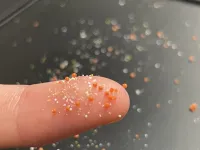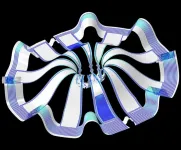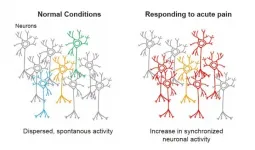(Press-News.org) Researchers from Columbia University and Temple University published a new paper in the Journal of Marketing that examines how choice architecture can reduce socioeconomic disparities.
The study, forthcoming in the Journal of Marketing, is titled "Do Nudges Reduce Disparities? Choice Architecture Compensates for Low Consumer Knowledge" and is authored by Kellen Mrkva, Nathaniel Posner, Crystal Reeck, and Eric Johnson.
As Mrkva explains, "Our research demonstrates that people with low socioeconomic status (SES), low numerical ability, and low knowledge are most impacted by nudges. As a result, 'good nudges,' designed to encourage selection of options that are in people's best interests, reduce SES disparities, helping low-SES people more than high-SES people." On the other hand, nudges that encourage selection of inferior options exacerbate disparities relative to "good nudges" because low-SES consumers are more likely to retain inferior default options. In other words, nudges are a double-edged sword that can either reduce disparities or make matters worse because they impact low-SES people most. The research team generalized its findings across three different types of nudges, several different consumer decision contexts, and real retirement decisions.
This research has major implications, including for the COVID vaccination process. Across the country, millions of people are now eligible to get a COVID vaccine. However, the signup process is often unnecessarily complex. New York's nycHealthy sign-up portal, for example, includes as many as 51 questions and requests that you upload your insurance card. As a result, many people, especially the elderly, poor, and less digitally literate, have struggled or failed to make an appointment. As Johnson explains, "Our research suggests that making beneficial behaviors like vaccination simpler has a crucial and underappreciated advantage--it reduces socioeconomic disparities. On the other hand, when these behaviors are unnecessarily complex, it is typically low-SES consumers who are harmed the most."
In five experiments as well as data from real retirement decisions, the researchers show that people who are lower in SES, domain knowledge, and numeracy are impacted more by a variety of nudges. As a result, "good nudges" that facilitate selection of welfare-enhancing options reduce disparities by helping low-SES, low-knowledge, and low-numeracy consumers most.
In Study 1, participants made five consumer financial decisions. For each decision, they were randomly assigned to a "no default," "good default," or "bad default" condition (the latter two pre-selected correct or incorrect options, respectively). After they made these five decisions, participants completed common measures of the three hypothesized moderators--financial literacy, numeracy, and socioeconomic status. As predicted, there was a large default effect. There were also interactions between the default condition and the three moderators; participants lower in these moderators were more impacted by defaults. These effects remained significant when adding survey engagement, comprehension, need for cognition, agreeableness, decision time, and their interactions with condition to the model as covariates.
Study 2 examines whether these effects generalized across three different types of nudges and three decision contexts. It replicated the SES and financial literacy effects of Study 1 across all nudges and contexts. Unlike Study 1 and all subsequent studies, the nudge x numeracy interaction was not significant. The key effects remained significant when controlling for a measure of fluid intelligence.
Study 3 uses syndicated data from stratified random samples of American households about their retirement investment decisions to examine a sample of people who work for companies that use defaults to automatically enroll employees into retirement contributions. Respondents reported whether they retained or opted out of the default contribution amount and default investment allocation. Evidence supports that lower-SES and less financially literate people are more impacted by nudges and thus less likely to opt out of these retirement defaults: Lower-SES participants were less likely to opt out as were participants with lower financial literacy.
Study 4 replicated these effects in the context of COVID-19 health decisions (e.g., deciding whether to wear a mask). Additionally, domain-specific health knowledge moderated default effects whereas other-domain knowledge did not. Studies 5-6 replicated the predicted moderators from Study 1 with incentives. Mediation models suggest that people with lower SES, domain knowledge, and numeracy were more impacted by nudges partly because they experience higher uncertainty and decision anxiety when making decisions.
Across the six studies, nudges influenced choice disparities across people. Posner summarizes the study by saying "Our results suggest that nudges that make behaviors such as retail purchases, vaccine sign-up, and retirement contributions more automatic can reduce socioeconomic inequities."
INFORMATION:
Full article and author contact information available at: https://doi.org/10.1177/0022242921993186
About the Journal of Marketing
The Journal of Marketing develops and disseminates knowledge about real-world marketing questions useful to scholars, educators, managers, policy makers, consumers, and other societal stakeholders around the world. Published by the American Marketing Association since its founding in 1936, JM has played a significant role in shaping the content and boundaries of the marketing discipline. Christine Moorman (T. Austin Finch, Sr. Professor of Business Administration at the Fuqua School of Business, Duke University) serves as the current Editor in Chief.
https://www.ama.org/jm
About the American Marketing Association (AMA)
As the largest chapter-based marketing association in the world, the AMA is trusted by marketing and sales professionals to help them discover what is coming next in the industry. The AMA has a community of local chapters in more than 70 cities and 350 college campuses throughout North America. The AMA is home to award-winning content, PCM® professional certification, premiere academic journals, and industry-leading training events and conferences.
https://www.ama.org
It's estimated that an average-sized wastewater treatment plant serving roughly 400,000 residents will discharge up to 2,000,000 microplastic particles into the environment each day. Yet, researchers are still learning the environmental and human health impact of these ultra-fine plastic particles, less than 5 millimeters in length, found in everything from cosmetics, toothpaste and clothing microfibers, to our food, air and drinking water.
Now, researchers at New Jersey Institute of Technology have shown that ubiquitous microplastics can become 'hubs' for antibiotic-resistant bacteria ...
ROCHESTER, Minn. -- Low representation of minority groups in public genomic databases may affect therapy selection for Black patients with cancer, according to new Mayo Clinic research published in npj Precision Oncology.
The researchers investigated the use of genomic databases and found that tumor mutation burden was significantly inflated in Black patients compared to White patients.
As a result of the study, clinicians who are using public genomic databases need to be aware of the potential for inflated tumor mutation burden values and how that may affect therapy selection and outcomes, especially for patients from underrepresented groups.
Clinicians use biomarkers, which are indicators of a disease or condition, to determine ...
BOSTON - Researchers have used a genetic engineering strategy to dramatically reduce levels of tau--a key protein that accumulates and becomes tangled in the brain during the development of Alzheimer's disease--in an animal model of the condition. The results, which come from investigators at Massachusetts General Hospital (MGH) and Sangamo Therapeutics Inc., could lead to a potentially promising treatment for patients with this devastating illness.
As described in Science Advances, the strategy involves a gene regulation technology called zinc finger protein transcription ...
A team of scientists, led by researchers at Northwestern University, Shirley Ryan AbilityLab and the University of Illinois at Chicago (UIC), has developed novel technology promising to increase understanding of how brains develop, and offer answers on repairing brains in the wake of neurotrauma and neurodegenerative diseases.
Their research is the first to combine the most sophisticated 3-D bioelectronic systems with highly advanced 3-D human neural cultures. The goal is to enable precise studies of how human brain circuits develop and repair themselves in vitro. The study is the cover story for ...
In a world first, a cross-institutional research collaboration has used a two-photon microscope (*1) with a combination of calcium imaging (*2) and holographic stimulation (*3) to reveal that the functional connectivity between neurons located in the primary somatosensory cortex is increased in response to acute pain.
Pain occurs as a result of injury, such as peripheral neuron damage or inflammation stemming from peripheral tissue violation. Research findings have been published on the involvement of central nervous system abnormalities in the onset of pain and sustained pain. The primary somatosensory cortex ...
COLUMBUS, Ohio - Most stroke victims don't receive treatment fast enough to prevent brain damage. Scientists at The Ohio State University Wexner Medical Center, College of Engineering and College of Medicine have developed technology to "retrain" cells to help repair damaged brain tissue. It's an advancement that may someday help patients regain speech, cognition and motor function, even when administered days after an ischemic stroke.
Engineering and medical researchers use a process created by Ohio State called tissue nanotransfection (TNT) to introduce genetic material into cells. This allows them to reprogram skin cells to become something ...
New York, NY--March 19, 2020--Columbia Engineering researchers, working with Brookhaven National Laboratory, report today that they have built designed nanoparticle-based 3D materials that can withstand a vacuum, high temperatures, high pressure, and high radiation. This new fabrication process results in robust and fully engineered nanoscale frameworks that not only can accommodate a variety of functional nanoparticle types but also can be quickly processed with conventional nanofabrication methods.
"These self-assembled nanoparticles-based materials are so resilient that they could fly in space," says Oleg Gang, professor ...
PITTSBURGH, March 19, 2021 - Non-circulating memory T cells, whose main function is to provide local protection against re-infection, contribute to chronic transplant rejection, University of Pittsburgh School of Medicine researchers reveal in a paper published today in Science Immunology.
The scientists show that these "tissue-resident memory T cells" are harmful in situations where antigens that the cells recognize are present in the body for a long time, such as in cases of an organ or tissue transplant. This finding is an important step toward improving therapies to help prevent organ rejection in transplant recipients.
"Tissue-resident memory T cells serve an important surveillance function," said co-senior author Martin Oberbarnscheidt, ...
CAMBRIDGE, MA -- Many viruses infect their hosts through mucosal surfaces such as the lining of the respiratory tract. MIT researchers have now developed a vaccination strategy that can create an army of T cells that are ready and waiting at those surfaces, offering a quicker response to viral invaders.
The researchers showed that they could induce a strong memory T cell response in the lungs of mice by giving them a vaccine modified to bind to a protein naturally present in mucus. This can help ferry the vaccine across mucosal barriers, such as the lining of the lungs.
"In this paper, we specifically focused on T cell responses that would be useful against viruses or cancer, and our idea was to use this protein, albumin, as sort of a Trojan horse to ...
To understand the fundamental properties of an industrial solvent, chemists with the University of Cincinnati turned to a supercomputer.
UC chemistry professor and department head Thomas Beck and UC graduate student Andrew Eisenhart ran quantum simulations to understand glycerol carbonate, a compound used in biodiesel and as a common solvent.
They found that the simulation provided detail about hydrogen bonding in determining the structural and dynamic properties of the liquid that was missing from classical models. The study was published in the Journal of Physical Chemistry B.
Glycerol carbonate could be a more environmentally ...




